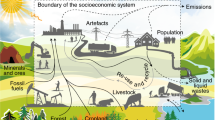Abstract
This paper presents empirical data to validate two points. (1) An integrated analysis of societal metabolism bridges an economic view of changes in socioeconomic systems with a biophysical representation of them. To obtain this check, it compares a biophysical indicator of development BEP with 24 traditional indicators of material economic development. The comparison covers a sample of 107 countries of the world, comprising more than 90% of the total world population (year 1993). (2) The concept of societal metabolism is useful to make biophysical analysts aware of constraints implied by “economic viability” and to make economic analysts aware of constraints implied by “biophysical viability.” To prove this point three practical examples of misunderstanding in the field of sustainability analysis are discussed.
Similar content being viewed by others
REFERENCES
Abernethy, V. (1991). Editorial: How Julian Simon could win the bet and still be wrong. Population and Environment, 13 (1), 3–7.
ACC/SCN. (1993). Second report on the world nutritional situation. Rome: FAO.
Brown, J.H., & West G.B. (Eds.). (2000). Scaling in Biology. Oxford, UK: Oxford University Press.
Cleveland, C.J., Costanza, R., Hall, C.A.S., & Kaufmann, R. (1984). Energy and the U.S. Economy: A biophysical perspective. Science, 225, 880–889.
Costanza, R. (1980). Embodied energy and economic valuation Science, 210, 1219–1224.
Duchin, F. (1996). Ecological Economics: the second stage. In R. Costanza, J. Martinez-Alier & O. Segura (Eds.), Getting down to earth: practical applications of ecological economics.Washington DC: Island Press/ISEE.
Ehrlich, P.R. (1986). The population bomb. New York: Ballantine.
FAO. (1995). Production Yearbook 1994. Rome: FAO Statistic Series No. 125.
Frank, J.R., & Smith, W.H. (1987). Perspective on biomass research. In: Smith, W.H., Frank, J.R. (Eds.), Methane from biomass: a system approach, pp. 455–464. New York: Elsevier Applied Sciences.
Georgescu-Roegen, N. (1971). The entropy law and the economic process. Cambridge, MA: Harvard University Press.
Giampietro, M. (1997a). The link between resources, technology and standard of living: A theoretical model. In L. Freese (Ed.), Advances in human ecology, Vol. 6, pp. 73–128.Greenwich, CT: JAI Press.
Giampietro M. (1997b). Socioeconomic pressure, demographic pressure, environmental loading and technological changes in agriculture. Agriculture, Ecosystems and Environment, 65, 201–229.
Giampietro M. (1997c). Socioeconomic constraints to farming with biodiversity, Agriculture Ecosystems and Environment, 62, 145–167.
Giampietro, M. (1998). Energy budget and demographic changes in socioeconomic systems.In U. Ganslösser & M. O'Connor (Eds.), Life science dimensions of ecological economics and sustainable use, pp. 327–354. Fürth: Filander Verlag.
Giampietro, M. (1999). Economic Growth, human Disturbance to Ecological Systems and sustainability.In L.R. Walker (Ed.), Ecosystems of disturbed ground, pp. 723–745. Amsterdam: Elsevier.
Giampietro M., & Mayumi K. (1997). A dynamic model of socioeconomic systems based on hierarchy theory and its application to sustainability. Structural Change and Economic Dynamics 8 (4), 453–470.
Giampietro, M., & Mayumi, K. (2000). Jevons' paradox, scaling in Societal Metabolism and the fairy tale of Kuznets curves. Paper prepared for the 3rd ESEE conference held in Vienna, May 2000.
Giampietro M., & Pastore G. (1999). Biophysical roots of “enjoyment of life” according to Georgescu-Roegen's bioeconomic paradigm. In K. Mayumi & J. Gowdy (Eds.), Bioeconomics and sustainability: Essays in honor of Nicholas Georgescu-Roegen, pp. 287–325.Edward Elgar Publisher.
Giampietro, M., Bukkens, S.G.F., & Pimentel, D. (1994). Models of energy analysis to assess the performance of food systems. Agricultural Systems, 45 (1), 19–41.
Giampietro, M., Bukkens S.G.F., & Pimentel D. (1997). The link between resources, technology and standard of living: Examples and applications. In L. Freese (Ed.), Advances in human ecology, Vol. 6, pp. 129–199. Greenwich, CT: JAI Press.
Giampietro, M., Ulgiati, S., & Pimentel, D. (1997b). Feasibility of large-scale biofuel production: Does an enlargement of scale change the picture? Bioscience 47(9), 587–600.
Giampietro, M., Bukkens, S.G.F., & Pimentel, D. (1993). Labor productivity: A biophysical definition and assessment. Human Ecology 21(3), 1–32.
Hall, C.A.S., Cleveland, C.J., & Kaufmann, R., (1986). Energy and resource quality. New York: Wiley.
Holdren, J.P. (1982). Energy hazards: what to measure, what to compare. Technology Review 85, 32–38.
ISTAT. (1992). Annuario Statistico Italiano. Rome. Istituto Centrale di Statistica.
James, W.P.T., & Schofield, E.C. (1990). Human energy requirement. Oxford: Oxford University Press.
Kaufmann, R. (1992). A biophysical analysis of the energy/real GDP ratio: Implications for substitution and technical change Ecological Economics 6, 35–56.
Peters, R.H. (1986). The ecological implications of body size. Cambridge, UK: Cambridge University Press.
Rothman, D.S. (1998). Environmental Kuznets Curves—Real progress or passing the buck? A case for consumption-based approaches Ecological Economics 25, 177–194.
Rothman, D.S., & de Bruyn, S. (Guest Editors). (1998). Special Issue on The Environmental Kuznets Curve Ecological Economics 25.
Schiefelbein, G.F. (1989). Biomass thermal gasification research: Recent results from the United States DOE's Research Program. Biomass 19, 145–159.
Simon, J. L., (1981). The ultimate resource. Princeton, NJ: Princeton University Press.
Stuckey, D.C. (1986). Biogas: a global perspective. In M.M. El-Halwagi (Ed.), Biogas technology, transfer and diffusion. Amsterdam: Elsevier.
United Nations. (1995). Statistical Yearbook. 1993. New York: U.N. Department for Economic and Social Information and Policy Analysis; Statistical Division.
U.S.BC (U.S. Bureau of the Census), (1994). Statistical Abstract of the United States 1994. U.S.Department of Commerce, Washington, DC.
World Bank. (1995a). Social Indicators of Development 1995. Baltimore: The Johns Hopkins University Press.
World Bank. (1995b). World Tables 1995. Baltimore: The Johns Hopkins University Press.
Author information
Authors and Affiliations
Rights and permissions
About this article
Cite this article
Pastore, G., Giampietro, M. & Mayumi, K. Societal Metabolism and Multiple-Scale Integrated Assessment: Empirical Validation and Examples of Application. Population and Environment 22, 211–254 (2000). https://doi.org/10.1023/A:1026695724208
Issue Date:
DOI: https://doi.org/10.1023/A:1026695724208




